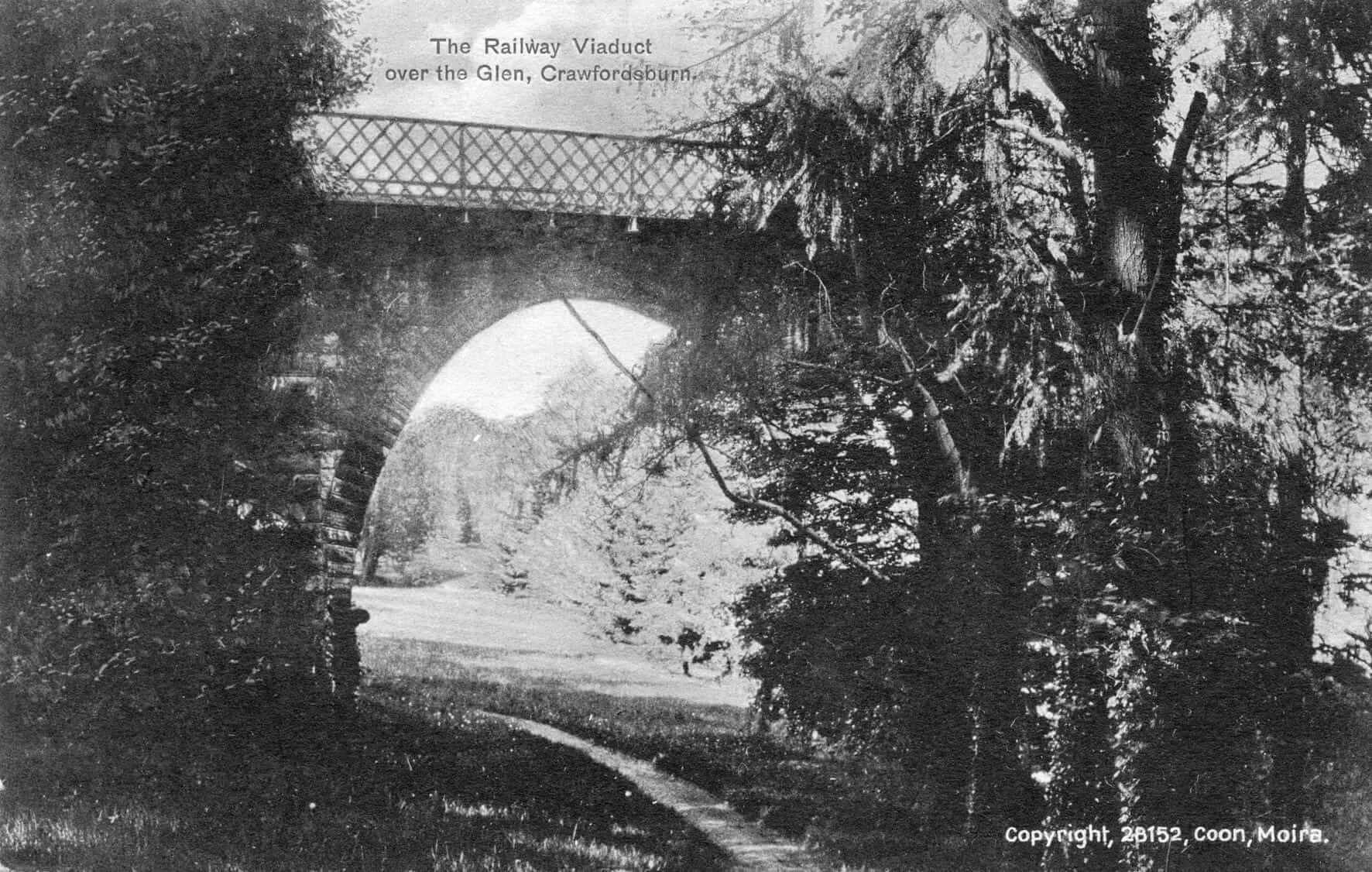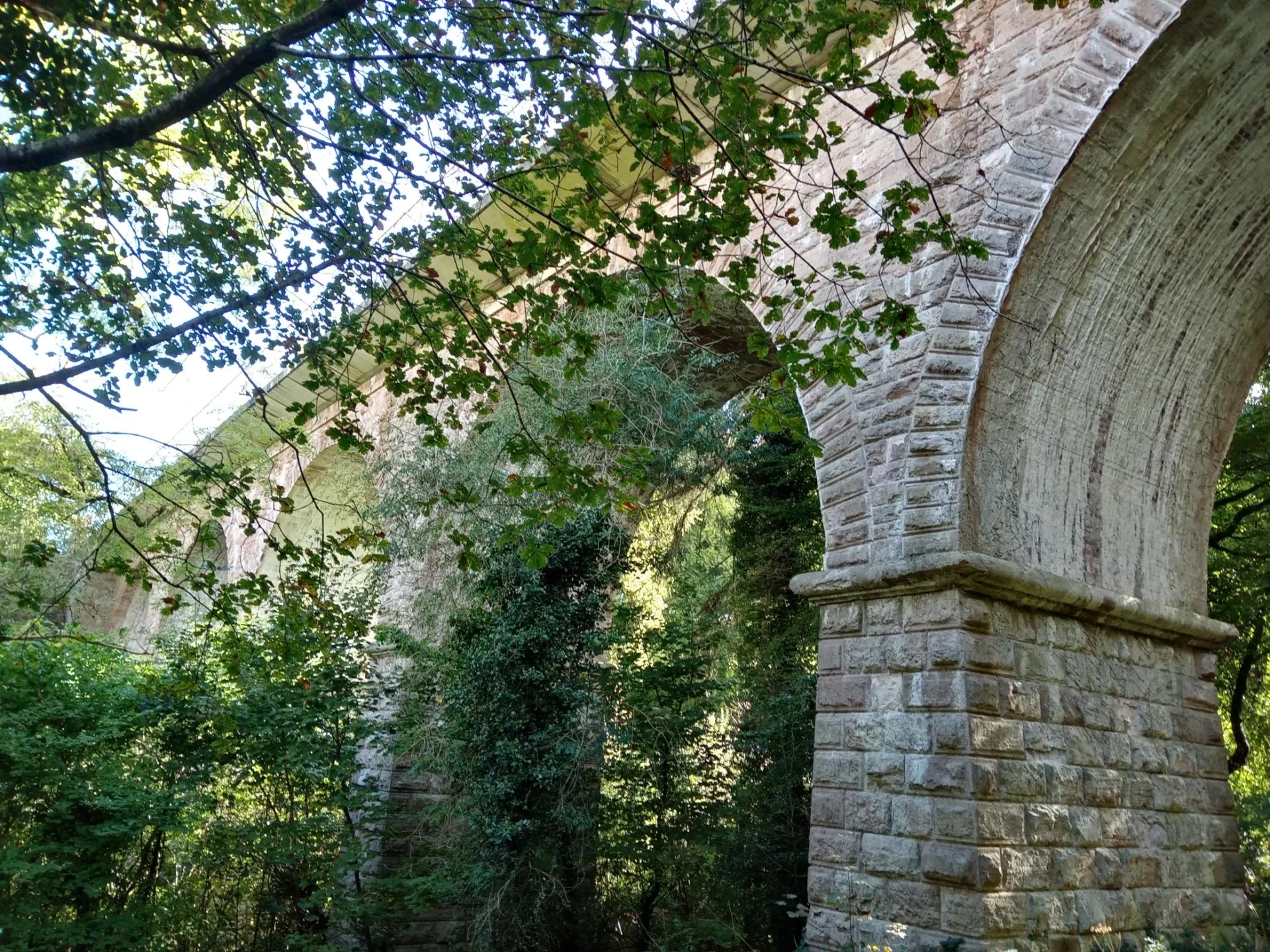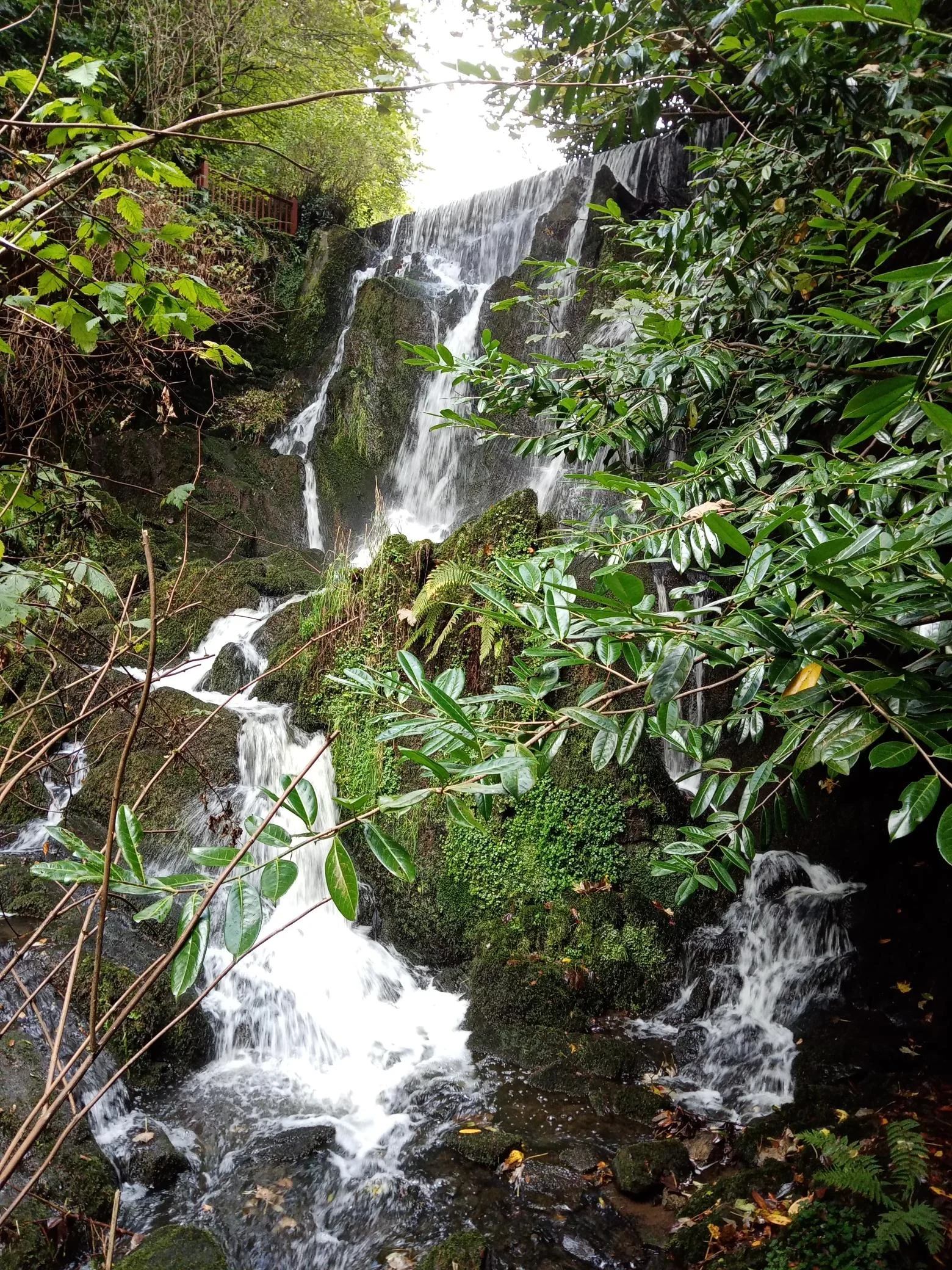
The Crawfordsburn Viaduct and the Glen
The erection of the Crawfordsburn viaduct was the largest engineering challenge in the building of the railway line from Holywood to Bangor by the Belfast, Holywood and Bangor Railway Company (BHBR). Their architect was the renowned Charles Lanyon.
The railway had to span the wide Crawfordsburn glen which was already a local feature. Writing in the 1850s, Edward Sloan began a poem about Crawfordsburn as follows:
‘A lovely summer’s evening sun
With burnished gilding crowned the trees,
And drooping hung the listless leaves,
Scarce waken’d by the whisp’ring breeze,
As, musing, forth I lonely strayed,
My laggard steps were slowly turned
To the sweet, winding walks within
The lovely glens of Crawfordsburn.’
The Downpatrick Recorder for 20 July 1850 has an article headed ‘Disgraceful outrage at Crawfordsburn’:
‘The beautiful grounds and gardens at Crawfordsburn, the property of W. Sharman Crawford, Esq, MP, are open to the public with the utmost liberality, and neither trouble nor expense is spared the accommodation of visitors. A new Gothic bridge, for example, has this year been thrown across the river, so as to form a public passage from the gardens to the shore, and many other improvements have been effected for the advantage of visiting parties. Some time ago, however, certain persons, who, from their social position, ought to have been respectable, took advantage of the indulgence shown to them to tear up and wantonly scatter about the grounds a number of the richest and most valuable flowers in the garden. Again conduct of this kind cannot be too severely censured, and the name of the offenders ought to be forthwith published of the world, in order that their real character may be generally known.’

Even then, vandalism was an issue!
The Downpatrick Recorder reported on the laying of the foundation stone of the railway viaduct on 25 September 1863 in the presence of a large assemblage which included Lord Dufferin. The article explained that the construction of the Crawfordsburn viaduct was by then in an advanced state, although what was conventionally termed the ‘foundation stone’ had only recently been laid. The viaduct was to consist of five arches, each of 50 feet span, and would be about 80 feet above the river.
Major John Crawford, by now the owner of Crawfordsburn House, following his father William Sharman Crawford’s death, then:
‘Deposited in a cavity in the stone a hermetically sealed bottle containing copies of the Belfast newspapers and several coins of the present year. The opening in the stone was then covered with a brass plate, bearing an inscription listing [the names of all involved] … The stone was then adjusted in its place; Major Crawford put some water about it, and thereupon declared it duly laid – an announcement which was received with great cheering. After the termination of the ceremony, Major Crawford invited the spectators to his magnificent residence, situated a short distance from the scene of the operation which he had just performed and there he entertained them at a special déjeuner.’
The toast called by Major Crawford was ‘prosperity to the Holywood and Bangor Railway’. He said that the undertaking had been prosecuted with considerable vigour, though it had now ‘arrived at a stage in which it would necessarily encounter a good deal of difficulty’. The Major also proposed the health of Mr Lanyon ‘in the most eulogistic terms’.
In response, Mr Lanyon said that the public were deeply indebted to the landlords for the interest taken on the line which occasioned applause. ‘The inhabitants must feel grateful for the interest taken by Major Crawford and his late worthy father in this railway and kindred undertakings’. Toasts were then drunk to the health of Mr Edwards (the contractor), Mr Koch (the financier) and Lord Dufferin about whom Mr Ward said that ‘the interest he had taken in the line was all the more appreciated, because it had not been dictated by any motive of self-interest. The line was to him not very desirable, nevertheless he not only gave no opposition to it, but he favoured it in many respects.’
In reply, Lord Dufferin admitted that the support supplied by some of the other landowners along the line had been ‘more thorough and more enthusiastic’ than his own. He was very sure that whatever his private aesthetical feelings on the subject might be, 20 or 50 years hence those who stood in his shoes would be very much obliged to him for not having given any opposition to the carrying out of the project.
The article ended by assuring readers that ‘the men employed at the works were not forgotten, as they too had festivities provided for them’.
The viaduct was the most impressive construction along the line. A Bangor resident, William Seyers, later recalled being taken, as a child:
‘to see the viaduct at Crawfordsburn, just before the railway was finished. The scaffolding was taken down, planks were projecting out over the edge and loaded with stones. Tradesmen were lowered down to paint and clean the joints. These planks extended out about eight feet. My brother went out on them and danced, turned and extended his arms. I was dumbfounded and could not look. He would be about 12 years old at that time.’
The last keystone of the viaduct was laid on 13 February 1864, carrying the inscription ‘this stone was set by WHS Crawford Esq, February 1864’. The line to Bangor opened in summer 1865.
Tradition has it that, years later, a youngster fell off the viaduct but was saved from death by his clothes catching in trees on the way down. The original Scrabo sandstone parapets had to be replaced in steel, when the track was doubled between 1897 and 1902.
Bassett’s County Down Guide and Directory summed up the delights of the glen in 1886:
‘Mr A Sharman-Crawford is the owner of the charming place known as Crawfordsburn. A glen, cascade and tastefully planted grounds are among the attractions. This year Mr Sharman-Crawford made use of the water of the burn to generate electricity for lighting purposes. Lamps are erected in the glen, and one beside the cascade, on dark nights, producing a beautiful effect. The workmen’s cottages, and Mr Sharman-Crawford’s own residence, are also supplied with the electric light’.

By this time the original corn mill had been converted and no less than three saw-mills were powered by the burn.
In the 1920s concerts were still being held in the Glen, in the amphitheatre near the waterfall. One local resident remembers her mother being taken by train to her aunts at Carnalea, before they would come to attend the concert.
Local historian Margaret Garner noted that the area was sometimes known locally as ‘Grace’s Glen’, after a lady of that name who lived in the farm at Glenside.
The 1863 foundation stone was removed in 1990 by the Country Park authorities, the year after the centenary of Lanyon’s death. A Victorian cache of Belfast newspapers and coins placed there in a hermetically sealed bottle 127 years before by Major Sharman Crawford was revealed. The contents of the bottle were found well preserved.
A fresh time capsule was buried in the woods about 30 metres upstream of the viaduct in 2016, with the help of children from Crawfordsburn Primary School. The contents included a copy of the history of the railway written by local author Robin Masefield, Be Careful, Don’t Rush.

The Viaduct

